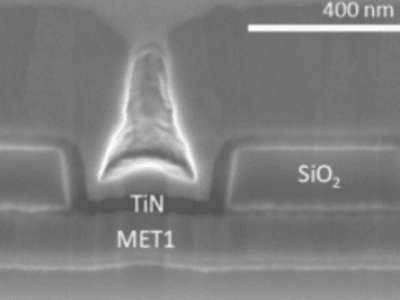
Spanish startup takes 1Gbit automotive Ethernet to plastic
Four surround-view cameras as well as an LTE-A antenna module linked to an SJA1105 E 802.3-compliant automotive Ethernet switch from NXP through KDPOF’s 1000BASE-RH ports.
Lifting the POF bundle, KDPOF’s Director for marketing and communications Óscar Ciordia highlighted the immediate benefits. “POF advantageously replaces copper because it weighs only a fourth of the equivalent length in twisted-pair copper cabling. It is impervious to electromagnetic interferences and unlike glass-based optical fibres, it is very rugged and can be bent without damage”.

Since its inception in 2010, the company has been focusing on the development of POF PHY interfaces and transceivers for high speed Ethernet. It released its first chip in 2014, serving consumers and telcos with POF-capable SOHO and home networking solutions.
“Four to five years ago, Broadcom was focusing on automotive Ethernet over twisted-pair copper cables. The result was the Broad-Reach line of 100Mbps automotive Ethernet PHYs and switches. But infotainment and more sophisticated features call for even more bandwidth, and car OEMs are now calling for 1Gbit/s or more” noted Ciordia. “But EMC issues are already a problem at 100Mbps, that’s why we’ve set our goal to deliver automotive Ethernet directly on POF”.
“It took BMW over a year to solve its EMC issues at 100Mbps on twisted-pair copper cables, it even had to delay a commercial launch. Jaguar-Land Rover does not even want to try with copper, they don’t want to face the same problems when moving to 1Gbps”, Ciordia told eeNews Europe.
So why wouldn’t other chip vendors move to POF instead of offering PHY solutions for copper? We asked.
“There is a lot of know-how in getting the signal right on POF, because there are more losses than on glass fibres. We use pulse-amplitude modulation with 16 discrete levels (PAM-16), we must filter out noise and equalize the channels. At the beginning, there was a couple of other companies working on this topic, but they left the market”, Ciordia said.
At the Ethernet & IP @ Automotive Technology Day, KDPOF announced two new transceivers, KD1051 and KD1052, implementing the physical layer of Ethernet to transmit data at 100Mbps over standard SI-POF (Step Index), MC-POF (Multi-Core) or Plastic Clad Silica (PCS). Both chips support different standards for the host digital interface, including RGMII, RMII, MII and, for the KD1052, 1000BASE-X and 100BASE-X. A Serial Management Interface is integrated for configuration and monitoring.

at 1Gbps over 40 meters of POF.
What’s more, these chips can also operate in 1Gbit/s mode for evaluation purposes and the company has already unveiled the specs of its next chip, an automotive GE-POF transceiver designed for normal operation at 1Gbps (over 40 meters of POF). Designed in a 65nm CMOS process, the automotive grade KD1053 will be sampling in 2017 in a 56-pin QFN 7x7mm package.
On its roadmap, KDPOF sees 10Gbps on POF the next logical step. “It is a bit more complex and we’ll have to use graded index plastic optical fibres instead of stepped index fibres”, admitted Ciordia, but we see the need for 10Gbit/s automotive Ethernet by 2025 and we hope to be ready by then.”
Without naming them, Ciordia told us that a German car OEM would use KDPOF’s transceivers in production vehicles starting 2018, while another unnamed OEM had planned its move to POF for 2020. “Even at 100Mbps, they are all coming to us and asking if we can solve their EMC problems. One of the projects we are involved in is an electric/hybrid vehicle.”
Ciordia makes public a number of on-going pre-developments at high-profile car OEMs evaluating its technology, including BMW who would use it for optical links for its “smart antenna module” and Daimler who could use it for its battery management system. Jaguar-Land Rover, Porsche and Volvo are evaluating the technology, while Toyota and Denso have started prototype development.
So, with only 25 staff members, how will a small startup address double sourcing in a cautious automotive market?
“We are considering some IP licensing deals with one or two Japanese silicon vendors looking to manufacture POF transceivers. We have not decided the type of design support we may offer with our IP, we want to enable double-sourcing but still keep our market lead”, confessed the Marketing and Communication Director.

Interestingly, on KDPOF’s stand was prominently displayed the O-GEAR project logo, a Japanese research effort led by Utsunomiya University (Tochigi) in partnership with Toyota to standardize the use of large core multimode optical fibres in car architectures: O-GEAR stands for Optical Gigabit Ethernet for Automotive aRchitecture. The O-GEAR project has supported IEEE’s 802.3 Ethernet standard with the specification of the physical layer for Gigabit Ethernet over Plastic Optical Fibres (GEPOF).
On a nearby booth, researchers from Utsunomiya University were exhibiting their own demo of an automotive GE-PON using a cheap passive optical network whose components (passive couplers, passive optical hubs) have long been commoditized by telcos in Fiber-to-the-Home (FTTH) deployments.

Here, four cameras around a Toyota toy car were streaming their data through a passive optical hub to a display, and to a Fibre Optic Transceiver (FOT) for further distribution onto the network via an Ethernet Gateway.
“There are doing interesting developments, and we do some work together”, acknowledged Ciordia.
Being in a unique position to serve high-speed automotive Ethernet on POF, KDPOF’s revenues expectations are rather high.
“Our goal is to grow our revenue from 2 or 3 million euros this year to 60 million by 2020. By then, the automotive sector could represent about 40% of our business” he concluded.
Visit KDPOF at www.kdpof.com
Visit O-GEAR at https://o-gear.pj.aist.go.jp
Related articles:
Automotive Ethernet needed for adaptive headlights, says Porsche
Test kit for real-time networks in automotive and industrial areas
NXP rolls Ethernet product family for next-gen data-rich cars
Marvell jumps gun on Gigabit Ethernet for cars
Ethernet to redefine E/E architectures
 If you enjoyed this article, you will like the following ones: don't miss them by subscribing to :
eeNews on Google News
If you enjoyed this article, you will like the following ones: don't miss them by subscribing to :
eeNews on Google News


